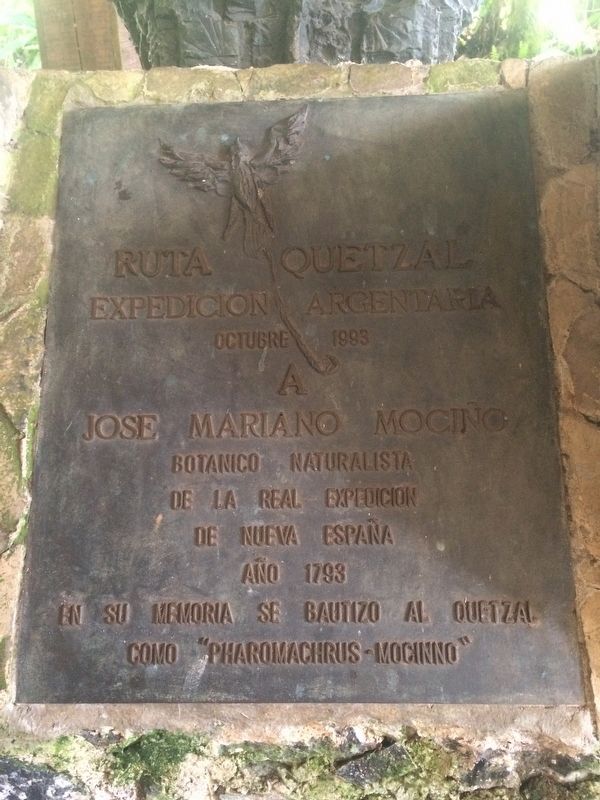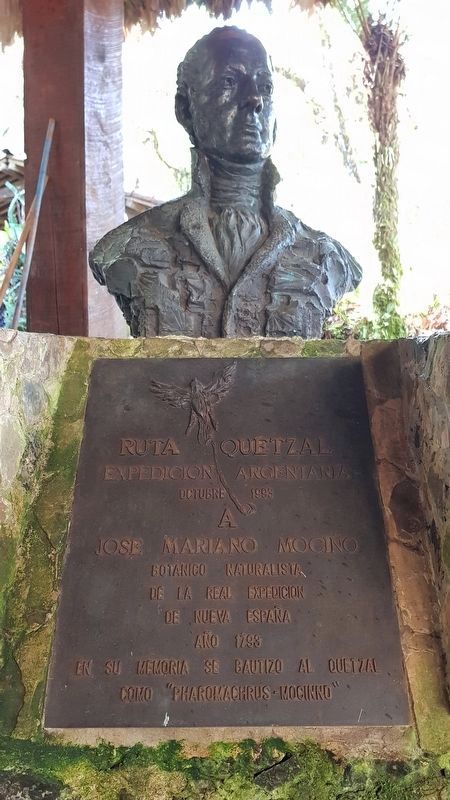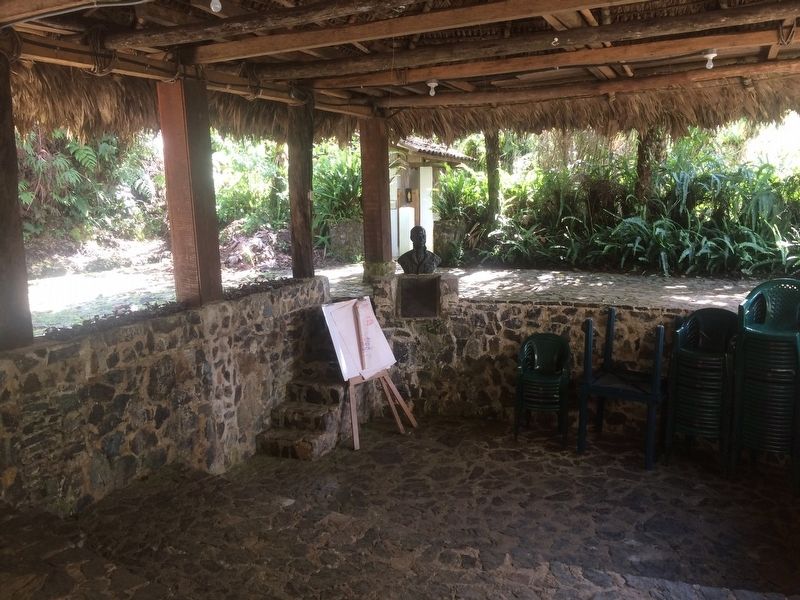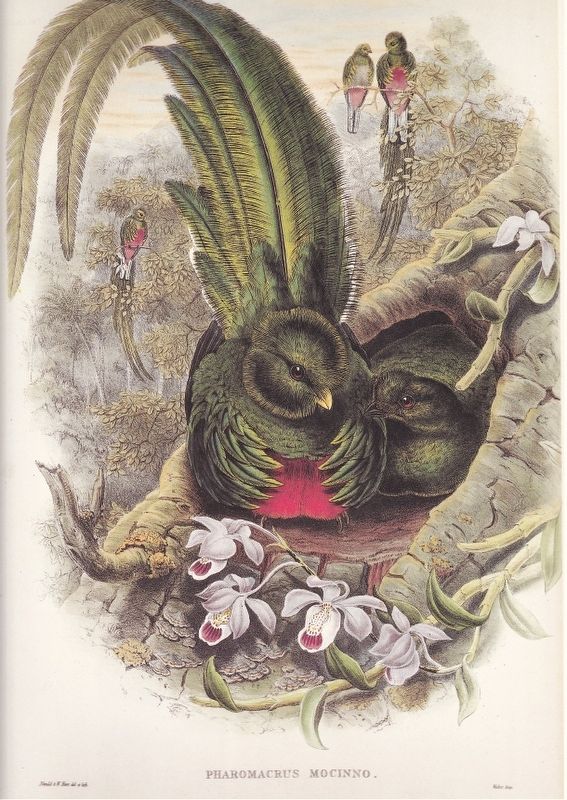Purulhá, Baja Verapaz, Guatemala — Central America
José Mariano Mociño
Expedicion Argentaria
Octubre 1993
a
Jose Mariano Mociño
Botanico naturalista
de la Real Expedicion
de Nueva España
año 1793
En su memoria se bautizo al quetzal
como “Pharomachrus - mocinno”
Argentinian Expedition
October 1993
to José Mariano Mociño
Naturalist and botanist
of the Royal Expedition
of New Spain
1793
In his memory the quetzal was named
"Pharomachrus mocinno"
Erected 1993.
Topics. This historical marker is listed in these topic lists: Environment • Exploration • Hispanic Americans. A significant historical month for this entry is October 1993.
Location. 15° 12.781′ N, 90° 13.034′ W. Marker is in Purulhá, Baja Verapaz. The marker is located underneath the bust of Mociño in an auditorium near the Vistors Center of the Biotope of the Quetzal near Purulhá, Baja Verapaz. Touch for map. Marker is in this post office area: Purulhá, Baja Verapaz 15008, Guatemala. Touch for directions.
Other nearby markers. At least 4 other markers are within 19 kilometers of this marker, measured as the crow flies. Sebastián Castro García (approx. 2.6 kilometers away); Salamá, Baja Verapaz (approx. 16.4 kilometers away); Miguel Angel Asturias (approx. 16.5 kilometers away); Reconstruction of the Tactic Parish Church (approx. 18.6 kilometers away in Alta Verapaz).
Also see . . . José Mariano Mociño at Wikipedia. José Mariano Mociño Suárez Lozano (1757 – 12 June 1820) was a naturalist from New Spain (modern day Mexico). After having studied philosophy and medicine, he conducted early research on the ecology (especially botany), geology, and anthropology of his country and other parts of North America. He was born in Temascaltepec (modern-day Mexico State) in 1757. Being poor, he worked in many different jobs in order to study in the Seminario Tridentino de México, where he devoted himself especially to physics, mathematics, botany, and chemistry. In 1778 he graduated in philosophy. In 1791 he was called to join the scientific expedition of Martín de Sessé, of the Royal Botanical Expedition, which had started in 1787. They traveled across New Spain, reaching the most inhospitable places, being especially notable his trips to the Pacific Northwest (modern-day U.S. states of California, Oregon, Washington and Alaska, and the Canadian province of British Columbia), among others. Although the pay for his job was minimal, he created one of the most important natural history collections of his times.
Beginning in 1795, by order of Charles IV, they made several journeys to examine Mexico. They traveled more than 10,000 miles (3,000 leagues) and formed a valuable collection, including a considerable herbarium and a great number of sketches, which they took to Spain in 1803. There Mociño was two times secretary and four times president of the Royal Medicine Academy of Madrid.
Mociño sympathised with Joseph Bonaparte, and when the French withdrew after the Peninsular War, he was taken prisoner, accused of being too close to the French. Finally, he managed to flee to France. In 1816 in Montpelier he met the naturalist Augustin Pyramus de Candolle, to whom he showed the collections he could save, and entrusted to him the manuscripts for a Flora Mexicana.
Candolle brought him to Geneva, where he became professor in the University of Geneva. In 1818 he returned to Spain. He asked Candolle to return his manuscripts, which Candolle did after having the talented botanical illustrator, Jean-Christophe Heyland, make copies of the plates. The originals are deposited at the botanical garden of Madrid along with the manuscripts for "Flora de Guatemala". He died in Barcelona, poor and blind, in 1820. He was the most famous American naturalist of the colonial period. Among his publications were "Descripción del Volcan Jorullo en versos latinos" (Mexico, 1801), and “Observaciones sobre la resina del hule,” published in the Anales de Ciencias Naturales (Madrid, 1804). Pablo de la Llave named the resplendent quetzal Pharomachrus mocinno to honour his mentor Mociño, who was the first to classify the bird. (Submitted on November 1, 2016, by J. Makali Bruton of Accra, Ghana.)
Credits. This page was last revised on February 14, 2020. It was originally submitted on November 1, 2016, by J. Makali Bruton of Accra, Ghana. This page has been viewed 433 times since then and 20 times this year. Photos: 1. submitted on November 1, 2016, by J. Makali Bruton of Accra, Ghana. 2. submitted on February 14, 2020, by J. Makali Bruton of Accra, Ghana. 3, 4. submitted on November 1, 2016, by J. Makali Bruton of Accra, Ghana.



